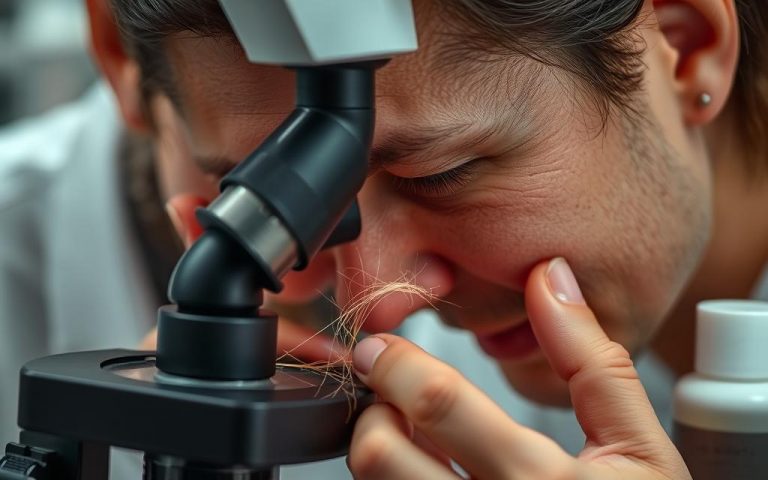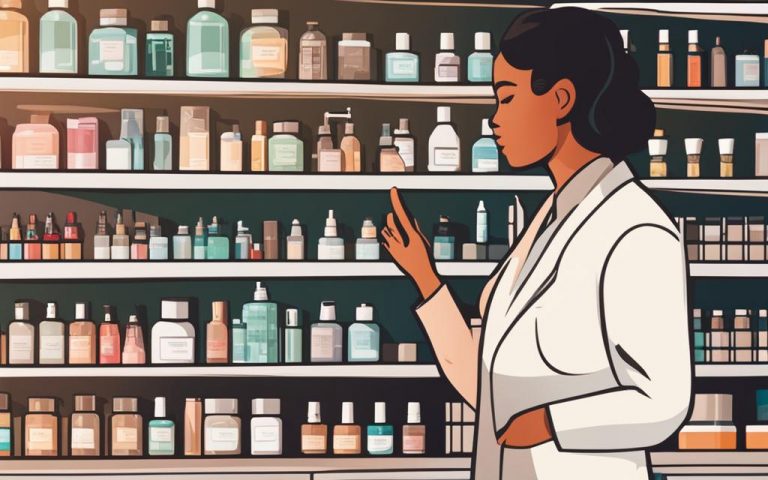Understanding PTSD Disorder: Symptoms & Care
Many think of veterans when they hear about Post-Traumatic Stress Disorder (PTSD). However, this disorder affects more than just military personnel. Anyone who has gone through or seen a traumatic event can face PTSD. Understanding the basics of PTSD care is vital. It helps not only those living with it but also their support circles. Here, we’ll explore what PTSD is, its various signs, and beginning steps for caring and managing it.
Key Takeaways
- PTSD affects individuals beyond the military – anyone can experience it after trauma.
- Recognizing the symptoms of PTSD is crucial in seeking timely help and support.
- Familiarizing yourself with the basics of PTSD care can be a game-changer for sufferers.
- Increasing PTSD disorder awareness empowers communities to support affected individuals.
- An introduction to PTSD is the first step toward understanding its complexities and impact.
What is PTSD Disorder?
Post traumatic stress disorder (PTSD) is a mental health condition triggered by a deeply traumatic event. Unlike normal stress, which is a short-term reaction to pressure, PTSD causes lasting, severe symptoms. It affects daily life and how one feels and acts.
Those with PTSD often relive the trauma through flashbacks, nightmares, and unwanted thoughts. These symptoms disrupt daily routines and change how a person reacts to their surroundings. They might feel more irritable, have trouble focusing, and get startled easily. Recognizing PTSD is key to understanding its difference from ordinary stress and the need for special treatment.
| Aspect | Regular Stress | Post Traumatic Stress Disorder |
|---|---|---|
| Duration | Temporary | Long-term |
| Trigger | General pressures (e.g., workload, deadlines) | Severe trauma (e.g., assault, natural disaster) |
| Symptom Patterns | Less severe, typically manageable | Intense, often debilitating |
| Impact on Life | Minimal to moderate | Extensive, affecting various aspects of life |
If you think you or someone close is showing signs of post traumatic stress disorder, getting help is crucial. Identifying the problem is the first step to recovery. It leads to treatment that can lessen symptoms, build resilience, and improve life quality.
The Causes and Risk Factors of PTSD
It’s important to know what causes PTSD and who is most at risk. This helps us tackle this mental health issue better. You’ll understand its effects and how to prevent or treat it.
Experiencing Traumatic Events
PTSD often starts after life-threatening events. This could be a severe accident, natural disasters, or acts of violence. These events can mess up how we think and feel.
If we don’t handle these experiences right, PTSD can develop.
Military Combat and PTSD
Military members face a high chance of getting PTSD. They are constantly in dangerous places. Being in war and violence ups their risk a lot.
Supporting our veterans’ mental health is key.
Personalization of Trauma
How someone sees and feels about a trauma affects PTSD risk. Past traumas, mental health, and how bad the event was matter a lot. This shapes their experience.
For more details on PTSD causes and risks, check the table below. It shows different events and their PTSD risks:
| Type of Traumatic Event | Associated PTSD Risk Factor |
|---|---|
| Personal Assault (e.g., sexual assault, robbery) | High |
| Natural Disasters (e.g., earthquakes, floods) | Moderate to High |
| Accidents (e.g., car accidents, workplace injuries) | Moderate |
| Exposure to War/Combat | Very High |
| Witnessing Death or Severe Injury | Moderate to High |
Understanding PTSD causes and risks lets you act early. You can prevent it or find help when needed.
Recognizing the Symptoms of PTSD
It’s key to spot PTSD signs early to help someone. We talk about symptoms like reliving trauma, avoiding reminders, and feeling on edge. Recognizing these can lead to quicker support and help.
Re-experiencing the Traumatic Event
People with PTSD may often relive their trauma. They might have nightmares or flashbacks. These experiences are intense and can make day-to-day life very hard.
This re-experiencing is a key sign of PTSD. It’s like the trauma is happening all over again. It feels impossible to control and can be overwhelming.
Avoidance and Numbing Behaviors
Those with PTSD might avoid things linked to their trauma. This includes places or people that remind them of it. It’s a major sign of PTSD.
They might also seem distant or uninterested in things around them. This numbing is like being emotionally checked out. It’s a way to not feel the pain.
Hyperarousal Symptoms in Daily Life
Hyperarousal is a big red flag for PTSD. It means being very anxious or on guard. Even when there’s no danger, they might be jumpy or easily scared.
This state can mess with sleep and make focusing hard. It lowers the quality of life. It shows how deeply PTSD can affect someone.
For more on how often and severe these symptoms can be, check the table below:
| Symptom Category | Frequency | Impact on Life |
|---|---|---|
| Re-experiencing Events | Daily | High |
| Avoidance Behaviors | Several times a week | Moderate to High |
| Hyperarousal | Constant | Severe |
Spotting these signs is crucial for early help. It’s also important for timely mental health care. This can really help manage PTSD symptoms.
The Physiological Impact of PTSD
When we talk about PTSD physiological effects, we mean how trauma affects the body and brain. The brain changes in PTSD alter how your nervous system handles stress. This can cause a series of responses that affect your health for a long time.
The core of these changes is in the brain’s structure and how it works. Parts of the brain important for managing fear and emotions, like the amygdala, hippocampus, and prefrontal cortex, change a lot. These changes affect how you handle emotions. They also make your fight-or-flight response stronger, raising stress hormone levels like cortisol.
Being exposed to these stress hormones for too long can cause health problems. These range from heart issues to problems with your immune system. It’s important to know about these changes. This knowledge can help you deal with symptoms and avoid health issues.
- High cortisol levels can mess with your blood pressure and sugar, which may cause hypertension and diabetes.
- Changes in how your brain functions can make it hard to remember things and focus, hurting your job and daily tasks.
- Having trouble controlling your emotions can lead to relationship issues and affect your mental health.
Now, let’s look at how long-term PTSD can lead to physical symptoms:
| Brain Area Affected | Function | Impact |
|---|---|---|
| Amygdala | Emotional processing | Heightened fear response |
| Hippocampus | Memory formation | Impaired memory recall |
| Prefrontal Cortex | Decision-making | Poor impulse control and trouble making decisions |
The changes in the brain mentioned can majorly affect how people with PTSD live daily. These physical effects also show how mental and physical health are deeply linked.
To wrap up, the brain changes in PTSD have big effects on a person’s life. Knowing about these changes is key for good treatment and support. This can help manage both the mental and physical symptoms of PTSD.
PTSD Treatment Options
Finding your way through PTSD recovery is key. Knowing about different PTSD treatment options and picking the right therapy for PTSD is essential. We will look into various therapies, medicines, and other methods to help those with PTSD.
Professional Therapy and Counseling
Professional therapy stands as a main form of treatment for PTSD. Techniques like Cognitive Behavioral Therapy (CBT) and Eye Movement Desensitization and Reprocessing (EMDR) are really helpful. They can assist you to deal with and move past your trauma safely.
Medications Used in PTSD Management
Medicines are vital in controlling PTSD symptoms. Most often, doctors prescribe antidepressants, such as SSRIs and SNRIs, to lessen depression and anxiety. Sometimes, antipsychotics or anti-anxiety drugs may also be used, depending on what the person needs.
Alternative and Complementary Therapies
There are other treatments besides traditional therapy and medicines. Practices like acupuncture, yoga, and meditation are becoming popular. They can support regular treatments by boosting well-being and helping with stress.
| Treatment Type | Description | Expected Benefits |
|---|---|---|
| Psychotherapy | Engaging with a trained therapist in regular sessions | Helps process trauma, reduces PTSD symptoms |
| Medications | SSRIs, SNRIs, or other prescribed drugs | Stabilizes mood, reduces anxiety, and improves sleep |
| Alternative Methods | Techniques like yoga, meditation, acupuncture | Enhances mental health, aids in stress management |
As you look into PTSD treatment options, make sure to talk to healthcare experts. They can customize therapy for PTSD based on what you need. This makes your treatment more effective. Remember, recovery from PTSD is different for everyone and may include a mix of treatments mentioned.
Coping With PTSD on a Daily Basis
Living with PTSD takes ongoing work and the ability to adapt. Here are things to do every day to manage your symptoms and take back control:
- Establish Routines: A daily plan helps give a feeling of safety and normal life.
- Practice Mindfulness: Simple methods like breathing exercises can stabilize your thoughts in tough moments.
- Utilize Support Systems: Connecting with friends, family, or groups provides comfort and help when you need it the most.
Adding these steps to your life won’t remove PTSD symptoms, but they are key in managing them day by day.
“Dealing with PTSD means welcoming support and taking active steps to care for your mind and body.”
Alongside these approaches, here are some structured methods to tackle daily hurdles:
| Activity | Benefit |
|---|---|
| Regular Exercise | Lessens stress and boosts physical health. |
| Scheduled Leisure | Gives you time to relax and enjoy, refreshing your mind. |
| Consistent Sleep Patterns | Improves mood and the way your brain works. |
A balanced daily routine gives you a foundation to better deal with stress and enhances your life quality.
Using these tactics does not guarantee an easy journey, but starting a daily routine is a forward move in healing.
Remember, the key to handling PTSD is to keep going and get support. Step by step, you can make a big change. Keep moving ahead, and reach out for help when it’s needed.
PTSD Therapy Techniques
Finding the right therapy for post-traumatic stress disorder (PTSD) is a big step toward recovery. We will look into various therapies that help with different aspects of PTSD.
Cognitive Behavioral Therapy (CBT)
CBT is a key therapy for PTSD. It focuses on changing the thoughts that affect how we feel about traumatic events. By changing these thoughts, CBT can help lessen PTSD symptoms and make daily life better.
Exposure Therapy and Its Benefits
Exposure therapy is another important treatment method. It slowly exposes people to what frightens them, but in a safe way. This helps them become less sensitive to the trauma and reduces their discomfort.
Eye Movement Desensitization and Reprocessing (EMDR)
EMDR therapy works by using eye movements. These movements help process the feelings linked to bad memories. Over time, this can decrease the emotional pain and help people feel more stable.
Here’s a quick comparison of these therapies:
| Technique | Focus | Typical Duration | Effectiveness |
|---|---|---|---|
| CBT | Cognitive restructuring | 12-16 sessions | Highly effective for many |
| Exposure Therapy | Desensitization | Varies | Especially effective for vivid memories |
| EMDR | Processing distressing memories | 6-12 sessions | High effectiveness for PTSD symptoms |

Managing PTSD Triggers
Managing PTSD triggers well is key to taking back control for those affected by traumatic experiences. It involves recognizing your own triggers, learning how to deal with them, and creating a safe space. This helps reduce their impact.
Identifying Your Personal Triggers
Finding out what causes your PTSD flashbacks is a critical first step. Triggers differ greatly from person to person. They can be anything from certain sights, sounds, smells, to times of the day or emotional states. By writing down when you experience PTSD symptoms, you can spot patterns. This helps identify the triggers of your flashbacks.
Strategies for Dealing with Unexpected Triggers
Having strategies ready for unexpected triggers is important. Techniques like deep breathing, grounding exercises, or reaching out to someone supportive can be very helpful. For instance, grounding exercises focus your mind on the now. This is a big help in managing PTSD flashbacks.
Cultivating a Safe Environment
Making a safe environment is crucial to lessen PTSD triggers’ effects. You can do this by organizing your living area to avoid triggers or setting limits in your social life. It’s also important to teach and talk with your close ones. This way, they can help keep your environment safe.
| Trigger Type | Identification Strategy | Coping Strategy |
|---|---|---|
| Sounds | Keep a journal of triggers and responses | Use noise-canceling headphones in noisy environments |
| Visuals | Note specific visuals that initiate flashbacks | Practice focused diversion techniques (e.g., focused reading) |
| Times of Day | Track your emotional state at different times | Plan structured positive activities during identified times |
The Role of Support Systems in PTSD Recovery
Dealing with Post-Traumatic Stress Disorder is tough. Having a strong support system is key. It gives comfort and ways to handle tough situations. It’s crucial to have support from groups, loved ones, or pros. Each helps in its own way on the path to getting better.
Connecting with PTSD Support Groups
PTSD groups provide a safe space to talk and listen. They build a community that understands and supports each other. Feeling connected reduces loneliness, a common issue with PTSD.
The Importance of Family and Friends
Support from family and friends is very important. They’re often the main source of help and comfort. Aware family and friends can spot problems, help in tough times, and keep therapy on track. This support boosts the ability to cope with PTSD.
Finding Professional Support
Professionals like therapists offer treatments that meet individual needs. They understand PTSD deeply and help manage it effectively. Personalized care from these experts is a big part of recovery.
The recovery journey is different for each person. It may take time to figure out the best support mix. Openly talking about your needs and how you’re doing helps tailor your recovery process. It makes sure the help you get fits you well.
| Support Type | Benefits | Recommended Actions |
|---|---|---|
| PTSD Support Groups | Community, shared experiences, mutual encouragement | Regular attendance, active participation |
| Family and Friends | Emotional stability, practical support | Communication about triggers, involvement in therapy sessions |
| Professional Support | Customized treatment plans, professional coping strategies | Consistent sessions, adherence to prescribed treatments |
PTSD Recovery Strategies and Building Resilience
Effective PTSD recovery strategies aim for more than just easing symptoms. They also work on making you stronger against PTSD. This strength is called resilience. It’s your power to recover from stress or trauma.
Key to building resilience are therapy, caring for yourself, and doing things that matter to you. These steps can help you feel stronger and in control of your life.
You have the power to reshape your response to challenges, turning setbacks into comebacks.
Try these focused strategies on your recovery path:
- Regularly attend therapy sessions aware of trauma
- Create a personal set of calming techniques like mindfulness
- Make achievable goals that make you feel accomplished
- Do physical activities to improve your body and mind
- Connect with people, share stories, and support each other
Here’s a table showing how improving resilience helps in PTSD recovery:
| Resilience Aspect | Contribution to PTSD Recovery |
|---|---|
| Emotional Regulation | Helps control emotional ups and downs, bettering responses to triggers |
| Cognitive Flexibility | Makes adapting to new viewpoints easier and challenges PTSD-related rigid thoughts |
| Social Connectivity | Lessens loneliness by building a supportive community |
| Physical Well-being | Improves overall health, aiding in managing stress and anxiety |
Building resilience against PTSD means growing your ability to deal with trauma strongly. It’s about moving from just getting by to fully thriving.
Lifestyle Changes to Support PTSD Recovery
Adopting a healthy lifestyle for PTSD is crucial in taking back control. We’ll explore key lifestyle shifts beneficial for PTSD recovery. These include routines, physical activity, and eating well.
Importance of Routine and Structure
Having a daily plan can greatly lessen PTSD symptoms. It makes life less unpredictable, easing stress and anxiety. This way, you gain more control over your life and daily tasks.
Exercise and Physical Wellbeing
Combining exercise with PTSD recovery efforts can boost both your body and mind. Working out releases endorphins, which are your brain’s natural mood enhancers and pain relievers. It’s also a healthy way to deal with stress and can make you feel proud of your achievements.
Nutrition and PTSD
What you eat affects your brain and how you feel. Eating lots of fruits, veggies, lean meats, and grains can keep your mood steady. It’s good for your overall health too.
| Element | Benefits |
|---|---|
| Routine | Reduces unpredictability and anxiety, enhances a sense of control |
| Exercise | Releases endorphins, reduces stress, improves mood and physical health |
| Nutrition | Stabilizes mood, enhances mental clarity, supports overall well-being |
Making these changes can really transform your life, leading to a healthier PTSD recovery. Begin with small steps like regular meals and daily walks. Then, slowly add more changes to your life.
Navigating PTSD Resources and Getting Help
PTSD can be tough. Knowing where to find help and how to start is key. This guide points you to various supports. These include navigating health insurance for PTSD treatments and finding both local and online support groups.
Understanding Your Health Insurance Options
Choosing the right health insurance can ease the cost of PTSD treatment. Many plans cover therapy and counseling, crucial for managing PTSD. Review your policy to see what’s covered, how long you can receive therapy, and if it includes PTSD specialists. If your plan falls short, look into other options with better PTSD coverage.
Local and National PTSD Resources
In the U.S., there are many places to find PTSD help. From support groups in your community to the National Center for PTSD, help is there. Large hospitals and health institutions often have programs for treating PTSD. Social services in your area can also connect you with the right resources.
Leveraging Online PTSD Communities for Support
Online communities offer a space to share and find hope. Sites like MyPTSD and PTSD Forum let you talk about your challenges with others who understand. Joining these forums can break through the loneliness of PTSD. They offer a way to find encouragement and advice from around the world.
Understanding PTSD Disorder
Gaining insight into PTSD is key for people living with it and their families. Knowing how PTSD shows up can empower you to spot the signs. This is the first step towards managing and recovering from it.
This section highlights important points about PTSD. It will improve your knowledge and readiness to address or help others with this disorder. Let’s look back at the main aspects of PTSD covered here:
- Definition and Symptoms: PTSD is a mental health issue caused by seeing or living through something very scary. Symptoms include flashbacks, nightmares, severe anxiety, and constant thoughts about the event.
- Treatment Approaches: There are many ways to treat PTSD, like therapy, medications, and natural methods. This means treatment can be customized to meet each person’s needs.
- Support Systems: Having support from community, family, and professionals is crucial. It helps with recovery and dealing with daily PTSD challenges.
| Aspect of PTSD | Key Insight | Impact on Daily Life |
|---|---|---|
| Symptom Recognition | Spotting triggers and symptoms early is key to managing PTSD effectively. | Moderate to Severe |
| Treatment Options | Because treatments can be personalized, they tend to work better. They’re matched to each person’s unique experiences and symptoms. | High |
| Support Networks | Having reliable support helps with faster recovery and less feeling alone. | High |
With these insights, you or your loved ones can do more than just cope with PTSD. It’s important to talk openly about mental health and seek the right help. Remember, being understanding and patient is crucial on this journey.
Conclusion
We’ve learned that PTSD care is tough. It involves understanding many aspects of the disorder. From its symptoms and causes to various treatments, it’s been a journey. Each person’s journey towards healing needs bravery and persistence.
We now know more about PTSD, how it affects our bodies, and therapy’s role. It’s key to have support and make healthy lifestyle choices. Remember, healing from PTSD is ongoing. A strong support network and a mindful lifestyle help a lot.
If you’re dealing with PTSD, know you’re strong for facing it. The path may be hard, but you’re not walking it alone. Every step is progress. Use the resources and people around you. They can help lead to a more stable and calm life.
FAQ
What are the basics of PTSD care?
Understanding PTSD is the first step in caring for it. This means recognizing its symptoms and looking for treatments. Options include therapy, medication, and making lifestyle changes to help manage symptoms and improve life.
Professional counseling, being part of support groups, and practicing self-care are key. They all play a big role in the care process.
How can I tell if someone has PTSD?
PTSD signs cover flashbacks, nightmares, and severe anxiety. It includes uncontrollable thoughts about the traumatic event and avoiding triggering situations. Negative changes in mood and being extra reactive are also signs.
If you see a person showing these signs, they might have PTSD. It’s important they get checked by a professional.
What distinguishes PTSD from a normal stress reaction?
Normal stress reactions go away after a short time. However, PTSD involves long-lasting symptoms. These symptoms can disturb daily life and personal relationships.
They stick around despite efforts to deal with them. This is how PTSD is different from just feeling stressed.
Can PTSD lead to physiological changes in the body?
Yes, PTSD can change how the brain works and its chemistry. It affects parts of the brain involved with emotion, memory, and learning. Ongoing stress from PTSD can also harm physical health, leading to long-term health problems.
What therapy techniques are effective for PTSD?
Some therapies that work well for PTSD include Cognitive Behavioral Therapy (CBT), Exposure Therapy, and EMDR. They help people deal with trauma, find ways to cope, and lessen the impact of traumatic memories.
How can I cope with PTSD on a daily basis?
Daily PTSD coping involves having a routine and practicing mindfulness. Staying in touch with supportive people, not using harmful substances, and keeping active are also important. Learning to manage your triggers can make a big difference.
What’s the importance of support systems in PTSD recovery?
Support systems offer emotional help, practical aid, understanding, and validation. They can be made up of family, friends, professionals, and groups. Being part of a community gives encouragement, reduces isolation, and fights the stigma of PTSD.
How can lifestyle changes support PTSD recovery?
Lifestyle changes like a solid routine, regular exercise, and a good diet can provide stability and boost well-being. These can lead to better sleep, more energy, and improved control of PTSD symptoms.
What resources are available for individuals with PTSD?
People with PTSD can reach out to mental health professionals, join support groups, and participate in online communities. Mental health hotlines and organizations like the National Center for PTSD offer help and information on finding local assistance.
Why is awareness about PTSD disorder important?
Being aware of PTSD improves the way it’s understood, diagnosed, and treated. It helps in reducing stigma and motivates people to seek assistance. It also shows how to support those affected by PTSD and promotes community help for those in need.







